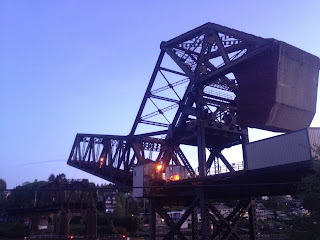The Trunnion Bascule Bridge, which exists in both single and dual-leaf forms, is probably the most generic and well known type of movable bridge. 'Bascule' comes from the French for 'Balance' and indeed that is what this design is all about. A large piece of concrete or some other counterweight is used to offset the weight of the span. To open, the span rotates on a trunnion, and as the counterweight goes down, the bridge goes up.
Let's see if we can't have a closer look at the parts of the bridge and how this works:
Sorry, I just love playing in AutoCAD. Anyway, we can see the center of rotation is the Trunnion, which in real life varies in diameter but can approach 2 feet, upon which the entire rotation is based. The trunnion is precisely machined (often of bronze) and is effectively a very large bearing. The large diameter is required because during rotation, the entire weight of the span and counterweight are more or less concentrated on it. The Counterweight, which is shown here as sort of a polygonal shape with diagonal stripes, is made of concrete and depending on density requirements can often include metal inserts for added weight. The last features of note here are the Live Load Shoes, which, when the bridge is closed, serve to carry the live loads of vehicle traffic instead of having them concentrate on the trunnion.
For simplicity's sake, I drew a typical single-leaf bridge. In bascule bridge terminology, a 'leaf' is simply the bridge deck, i.e. the moving part. There can be single- or dual-leaf designs. In the case of dual-leaf, instead of a live-load shoe at the 'toe' of the bridge leaf, there is a another bridge leaf. In order to limit relative vertical deflection between the bridge leafs at the joint, Span Locks are used. The most common span lock system is a linear prong which extends from one side of the joint to the other and slides into a receiver there. (A similar arrangement also secures a single-leaf bridge to its footing.) On the Lake Washington Ship Canal's four trunnion bascule bridges, these span locks are audible from the shore, and on the Montlake bridge especially, somewhat visible, particularly the flywheel of the span lock motor. The next time you walk on one of these bridges, look down through the joint on either side and try to find the span locks. They should be the only thing that bridges the gap from one side to the other.
Below are a couple of photos which should clarify the live load shoes. The bridge is the Fremont Bridge on the LWSC in Seattle, Washington, and is one of the busiest movable bridges in the United States.
 |
| Overview from near-elevation at about 1/3 full open |
Here we see the live load shoe and contact plate in both the open and near-closed position. As is plainly seen, the bridge rotates down and settles into position in the saddle shown. Keep in mind the massive scale of the components here, the railing is 3ft high or so, and as such the shoe and plate are probably around 18 inches square.
I know we covered a lot in this post and even still have not mentioned how these bridges are pulled open and shut. Next time we will look to Alameda, California and the Park Street Bridge which illustrates the gear system quite well. I may also take some pictures of the drive system on display at the South Park Bridge in Seattle, to exemplify the motors and gearing involved. Until then, see you soon!








